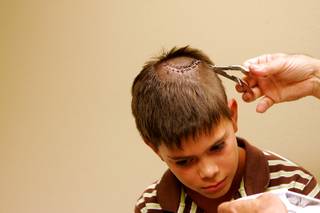Saturday, Oct. 9, 2010 | 2 a.m.
Related story
Pitching in the Danger Zone
Eleven-year-old Ben Gephart was pitching for the Henderson Mavericks on September 11, 2010, when the batter hit a line drive with his aluminum bat. The ball, which was going up to 80 mph, hit him on the left side of his head, fracturing his skull and paralyzing his right hand. After emergency brain surgery and 30 staples in his head, Gephart may be able to return to the pitching mound one day, but Ben's father and professional baseball instructor discuss the safety of aluminum bats.
Three youth baseball pitchers in Southern Nevada have been seriously hurt since Labor Day by being hit with balls hit off aluminum bats at distances of 50 feet or closer.
The injuries were a fractured skull, a broken nose and a ruptured ear drum. The incidents have spurred discussion among league officials about bat safety, whether protective masks should be worn during games and the psychological effects of batted-ball injuries.
Frederick Mueller, who tracks sports-related injuries for the National Center for Catastrophic Injury Research at the University of North Carolina, said the safety debate over aluminum versus wood bats has no concrete answer.
The science of determining how fast a batted baseball travels back to the pitcher’s mound is inexact, he said. What has to be factored in is how fast the pitcher throws the ball, how quickly the batter swings and what part of the bat meets the ball — variables that change on every play.
“Every time (an injury) happens, folks are up in arms, wanting to ban aluminum bats,” Mueller said. “There just isn’t enough reliable data that say one bat is safer than another bat.”
Mueller cited 23 reported incidents from 1983 to 2007 of high school pitchers who were injured by batted balls to the head or chest. Four died. Five incidents led to disability, and the rest fully recovered. The center doesn’t track injuries of younger players.
“It doesn’t happen very often, thank heavens,” Mueller said.
The most severe injury locally occurred Sept. 11 when 11-year-old pitcher Ben Gephart of Henderson fractured his skull after taking a line drive to the back of his head. The ball was going an estimated 75 mph.
He had emergency surgery two hours after the incident and still has paralysis in his right hand. Initially, the paralysis was in his entire arm.
It would seem logical for field players, especially pitchers, to wear more protection than a hat. But coaches say that won’t happen and that batted-ball injuries are part of the game — they happen at every level.
Just don’t tell that to Joe Pannullo, who coaches Ben on the Henderson Mavericks. He was first to the mound that Saturday morning when Ben went down and said the injury is something no child should endure.
“That was probably a one-in-a-million shot,” Pannullo said. “But one is enough for me. I would love to see pitchers wearing helmets with masks like softball pitchers.”
Most children in the recreation-based Northwest Girls Softball League wear face masks on the field. The device — which resembles a catcher’s mask with a bar on the front and straps to the back — probably would have prevented Nathan Waltans from breaking his nose.
Nathan, 11, was hit by a line drive while pitching for the Las Vegas Coyotes. He was able to get the bottom of his glove on the ball, but it didn’t do enough to stop the velocity.
“It just comes down to safety,” said Vern Stephens, president of the Northwest Girls Softball League. “If it is available for you and not a distraction, then why not? Bat companies are making bats bigger and better, like golf clubs, and these girls have better arms (than in years past). All it takes is one kid getting a hold of the ball.”
And then there is the mental aftershock of being injured.
Zachary Sangster, 11, returned to the Vegas Aces club team after rupturing his right ear drum in August.
When Zachary pitched in a game two weeks ago, he was timid in his approach and wild with his pitches. After a handful of pitches, he asked his coach to be moved to another position.
“He says he is ready, and he says pitcher is his favorite position,” said Mark Sangster, Zachary’s dad, “but it was a different story when he got out there.”
Coyotes coach Sean Dumm: “There is always a fear with the pitchers. They all seem to be a little afraid that something like that will happen again.
“The batters are hesitant to put forth their entire ability at the plate,” he added. “They don’t want to hurt anyone.”


Join the Discussion:
Check this out for a full explanation of our conversion to the LiveFyre commenting system and instructions on how to sign up for an account.
Full comments policy